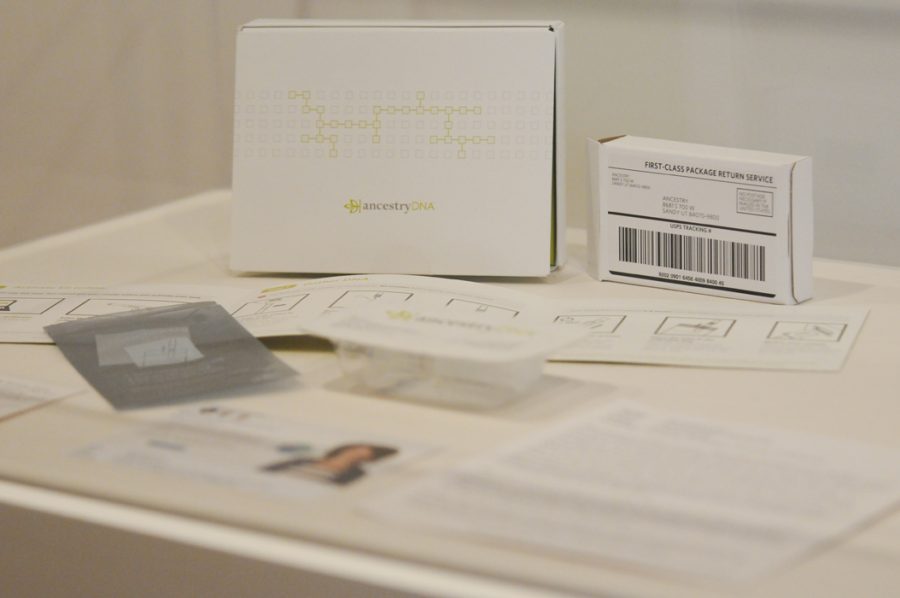Inside the Frick Fine Arts Building, a woman’s voice counts the seconds eerily and methodically through a speaker hidden amongst the stations while visitors stroll through the department’s current art exhibit.
Set against the all-black walls of the room, the consistent timekeeping was for visitors at interactive exhibits, who were measuring themselves in comparison to their peers or to humanity’s outliers — people who hold Guinness World Records for things like being the tallest man on earth or growing the longest moustache.
The exhibit, Data (after)Lives, is on display in Frick’s University Art Gallery from Sept. 8 to Oct. 14 and uses both art and data to explore the ways humans have measured ourselves. Mainly, humans have done so through numbers and quantification, such as measuring body parts and testing the limits of our senses.
Taken as a whole, the theme seems broad and abstract, but each of the distinctly separate exhibits sought to describe the experience of being human, said Alison Langmead, co-curator of the exhibit.
“We’re sort of questioning if [there’s] a stark divide between quantification of your experience and just the representation of your experience,” said Langmead, who is also the director of the visual media workshop and assistant professor of information sciences at Pitt.
Some of the displays in the exhibit point to starker human measurements than others.
In one display, an examination of Andrew Carnegie’s head shape — including his strong forehead — is part of a collection of textbooks describing eugenics, a controversial social philosophy based on improving human genetics.
In another, a series of original and recreated headshots by French criminologist Alphonse Bertillon rest within a display case spanning most of the wall.
Replicas of stools that people would have sat on while Bertillon took their measurements adorn the far end of the room. On top of the stools sit replicas of his calipers, a device to determine distance between two opposite sides of an object, like a human head.
Bertillon believed a person’s measurements — such as the distance between his eyes or ears — remained consistent throughout their life. He claimed that a measurement of someone’s features at one point in their life could be used to accurately identify them later on.
Until the beginning of World War I, Bertillon’s practices were widely adopted internationally, according to Josh Ellenbogen, director of graduate studies and associate professor of history and art at Pitt.
As a result, French criminals often hid their identities because of strict multiple offense laws, Ellenbogen said.
Ellenbogen curated the exhibit alongside Langmead and Richard Pell, associate professor of art at CMU as an extension of a project called Decomposing Bodies. That project is part of Pitt’s Visual Knowledge group, a thematic research team through Pitt’s History of Art and Architecture department.
Some pieces of the exhibit were interactive, inviting visitors to take part in measuring themselves or their abilities.
As the woman’s voice tracks time, visitors can test how long they can hold their hand over a candle flame or the amount of words they can read and remember within a given time span.
Though students are always welcome to tour the exhibit, the curators intended for art or art history classes to take advantage of the installations, according to Isabelle Chartier, curator of the University Art Gallery. She said classes could either think about the exhibit’s organization or dive into broader themes and implications of the exhibit.
“This exhibit, in a sense, starts a discussion, starts a research project, starts an essay for a course or maybe a publication in the future,” Chartier said. “Obviously, it’s open to everyone, but we try to directly connect it to courses offered this semester.”
While Bertillon aimed to create a record of real historical data on human measurements, Leticia Parente, the other artist featured in the installation of the exhibit, just wanted to make people think.
The exhibit includes a recreation of Parente’s 1976 Brazilian art installation “Medidas,” or “Measurements.” The installation originally ran in Rio de Janeiro and was comprised of about 12 interactive stations to offer measurements ranging from the scientific to the scandalous.
For the Data (after)Lives exhibit, Paulina Pardo, a third-year Ph.D. student studying Latin American studies and contemporary art at Pitt, recreated “Medidas” to make it only partially interactive as a way to preserve the work solely as art.
Although the installation utilizes science and mathematics — apparent in its inclusion of blood type testing — Pardo said its aim is to confront the audience with basic questions of human identity.
“On the one hand, it validates that people are just people, but on the other makes you think as part of a collective group,” Pardo said. “Even if you’re just one person, what is the system that you’re a part of?”
The current data-drenched world is driven by human curiosity, and Langmead said she hoped the Data (after)Lives exhibit would help undergraduates perceive their “native digitalness,” — or millennials’ reliance on digital mediums — as part of a larger continuum.
“Human beings have this long-standing tradition of producing data about themselves and allowing that data to control them in turn,” Langmead said. “And this isn’t a property specifically of the internet. It’s something humans do and have done.”



